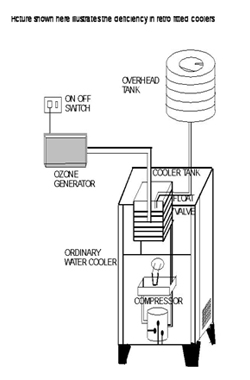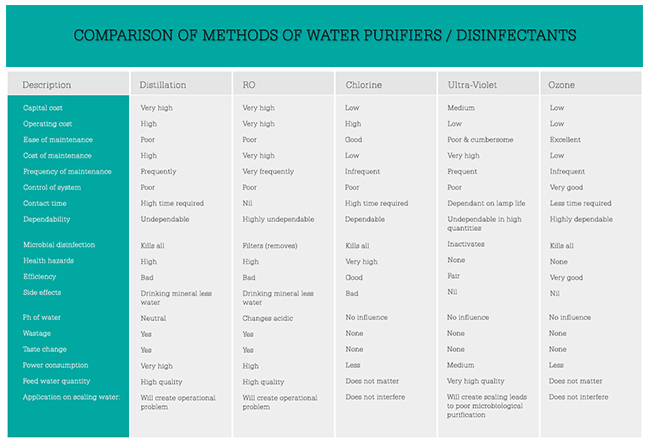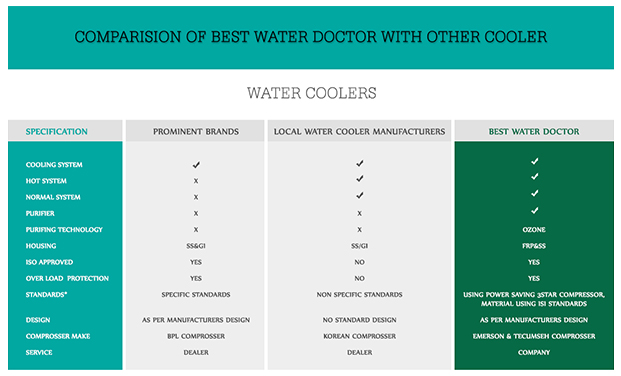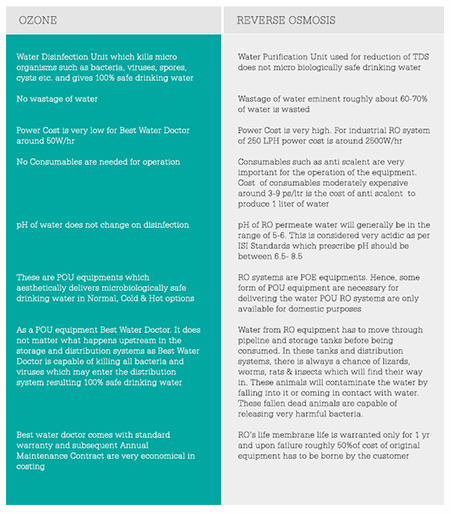Frequently Ask Questions

What is Retro- Fitted Water Coolers ?
Basically, it is a compromised situation where the water purifier manufacturer does not make water coolers as well as water cooler manufacturer does not make water purifier. It is mainly a make-shift arrangement to cater your needs.
The Disadvantages of retro fitted water coolers
When Water cooler and Ozone generator/ UV systems operate independently without syncing the following can occur
Water can be drawn even under the following conditions:
1. Without switching on the Ozone generator/UV systems
2. In power off condition
3. With Ozone generator failure condition/ UV system failure
4. Since the two products are bought from different manufactures servicing is always a problem. You might hear frequently service technicians blaming the other person for all warranty compromised situations. As a customer it also becomes difficult to know whom to call in times of breakdown.
Disadvantages of retro fitted water coolers with ozone:
1. Since a particular volume of Ozone must be mixed in the water to purify it, there is no advantage in using Ozone generator for float valve operated water storage system. The reasons are as follows:
2. The volume of water to be consumed by the public cannot be predicted. If one bottle of purified water is drawn, another one bottle of unpurified water mixes with the purified water through float valve.
3. This type of Ozone generator is operated with the timer (i.e.) once in 2
hours the Ozone generator works automatically in the Power on condition. So, there is a possibility of Excess Ozone mixing with the water during Holidays or even in the night hours when we forget to switch off the unit during closure.
The Cooler and Ozone generators are not manufactured by the same company. So two different service persons have to be called for servicing and both of them will not take the Responsibility when any serious problem arises.
Disadvantages of UV retro fitted water coolers:
1. Water from UV Filters has to be consumed immediately on delivery from the outlet. It cannot be stored because there is no residual effect for UV as in the case of OZONE or Chlorine. Water stored for consumption in the cooler, especially after non-use during the weekends, acts as breeding ground for bacteria, virus and germs.
2. U/V rays will not kill spores. This is the reason why generally the manufacturers recommend that water should be consumed as soon as it comes out of the unit. So water purified by this method cannot be stored at all.
3. Another fact to be considered is that the U/V rays inactivate bacteria by working on their DNA and stops the reproductive process of the Bacteria. Bacteria have a total life of 20 minutes and after it gets hit by U/V rays if it passes through a dark area the bacteria can reactivate but cannot reproduce. This process only inactivates bacteria but cannot destroy it. Thus in water coolers the water is stored for long periods without any additional purification thereby leading to Re-Growth.
ANYTHING EXCESS IS INJURIOUS TO HEALTH
Two Important Terms Related To Water Treatment
Water Purification:-
“The act of cleaning by getting rid of impurities”
For water treatment, this term refers to the process of removing specified contaminants from a water source. All effective water treatment methods will provide some amount of purification, however, only some methods will disinfect the water (Ultra filtration, Nano filtration, Micro filtration & Reverse Osmosis).
Water Disinfection:-
“Killing or removal of microorganisms outside the body by direct exposure to chemical or physical agents or processes”
For water treatment, this term refers specifically to a purification process that kills or removes biological contaminants (cysts, bacteria, viruses, protozoa’s etc.) from a water source. Water that has been disinfected (by UV treatment, boiling, chlorination, micro-filtration, ozone, etc.) may still be polluted with other contaminants that are not affected by the disinfection treatment. In some cases, additional contaminants may actually be added to the water by the disinfection process. For instance, the process of chlorination nearly always adds chlorine and frequently some disinfection byproducts (trigonometrical, like chloroform). Boiling water too long will concentrate inorganic contaminants. Sterilization refers to the process of killing or removing all microorganisms.
Thus, Water purification is entirely different from Water disinfection. Hence careful consideration is required by the consumer to decide between the above two.
1. Can RO water be used directly for consumption?
RO water will be chemically portable, but in certain times PH correction may be necessary with respective biological contamination and RO is not a proper disinfection process. Hence, suitable disinfectant should be used before consumption.
Moreover in all places Ro water is stored in overhead tanks where the water might get contaminated. Even in pipelines contamination is possible. Hence before drinking the Point Of Use (POU) system is considered to be the best form of treatment to kill bacteria & Virus is almost necessity.
2. How Reverse Osmosis can be differentiated from other filtration methods?
RO is the most convenient and effective method of water filtration. It filters water by squeezing water through a semi-permeable membrane, which is rated at 0.0001 micron (equals to 0.00000004 inch!). This is the technology used to make bottled water.
It is also the only technology capable of desalinating sea water, making it into drinking water. Non-RO water filters typically use a single activated carbon cartridge to treat water. They are much less effective, and the pore size on these filter media are much bigger, generally 0.5 – 10 micron. They can filter out coarse particles, sediments and elements only up to their micron rating. Anything finer and most dissolved substances cannot be filtered out. As a result, water is far less clean and safe compared to reverse osmosis filtration.
3. Can Reverse Osmosis be used for Potable or Low TDS Water? If used, what will be its effect?
RO is not advisable in cases of low TDS or Potable water because the above mentioned
water is naturally low in salts. If used RO will bring down TDS to very low level
and will be aggressive in nature thereby causing digestive disorders.
4. Will the taste & colour of water be changed while using reverse osmosis?
Of course, RO will make the salty water to tasty water and will also remove any colour present in water.
5. Will Reverse Osmosis remove all the essential nutrients in aater?
Yes, RO will remove all minerals in the water.
On this issue there is a lot of debate. We will explain the two sides of the story.
1st Group Advises:
Drinking RO water will not create any problems, because they feel the minerals that are present in the water is very less and cannot be absorbed by the body. Also most
of our body’s nutritional value comes from solid foods rather than water.
2nd Group Advises:
Drinking Mineral-less water will lead to bone brittleness. Also they advocate that water which is less in minerals will be aggressive in nature thereby causing digestive disorders. The above theories are not proven and only remains as theories.
6. Can Reverse Osmosis & other filtration techniques be used for domestic purpose?
Yes, there are small filters available which can be used for domestic purpose.
7. Is there a chance for microbes to get grown inside the membranes used in RO Systems?
In order to get microbe free water from an RO system the plant has to be maintained
effectively.
For Ex: In a very large De- Salination project, bacteria form on the membrane thereby leading to bacteria present in the product water. So, these big projects use biocides on every alternative period to kill any bacteria or virus present. But for normal industrial systems this is not viable on account of huge cost & man power. Hence for smaller RO system is used for only TDS removal and not for microbiological purification.
8. Does R.O. Remove Parasites Such As Bacteria, Cysts or Cryptosporidium?
Bacteria, Cysts, and Cryptosporidium are all too large to pass through the TFM membrane. NSF’s rating for reduction of Cysts and Cryptosporidium is 1 micron but the TFM membrane filters down to 1/10,000 of a micron, which is a lot smaller than the parasites.
9. Specifically, which contaminants does a reverse osmosis system remove?
A reverse osmosis system can treat for a variety of contaminants including: Aluminum, Arsenic, Asbestos, Atrazine, Benzene, Chlorides, Chlorine, Copper, Cryptosporidium, Cyanide, Fluoride, Giardia, Lead, Mercury, Nitrates, Radium, Radon, Silver, Sodium, Sulfide, Trichloroethylene, and Trihalomethanes.
10. Is this the best type of drinking water filter for my water?
This depends on the quality of the source water. Generally, if the water to be filtered is municipally-treated city water low in minerals, then less expensive carbon block filtration systems would be the best type. If the water is very high in minerals, then a reverse osmosis system or distiller that removes minerals, salts and chemicals may be desired. In our experience, folks generally prefer RO, since it provides purified, “bottled-quality” water, instead of just merely removing chlorine tastes like many filters.
11. How many of the minerals are removed by RO?
In most cases, 95 – 98% of the minerals, salts and other inorganic dissolved solids, such as metals, fluoride, sodium, and calcium is removed by a Thin Film Composite (TFC) RO system.
12. Will RO systems reduce lead?
Yes
13. Will RO system remove minerals or help cut down on scale buildup in coffee pots, steam irons, humidifiers etc.?
Yes! Most water contains “total dissolved solids” (TDS) , which is roughly the total inorganic mineral content of the water, and these are greatly reduced. The reverse osmosis membrane separates these dissolved solids or salts and flushes them down the drain.
14. Don’t we need these minerals in our drinking water?
According to many experts and studies, only a small percentage of the minerals in water are absorbed by the body. A far better source of minerals is found in foods such as green leafy vegetables, milk, soy products and fish etc.
15. How does RO water compare with bottled waters?
This depends on the bottled water. Many bottled waters use reverse osmosis to purify municipal tap water. Some add back in minerals after the purification process. Some bottled waters filter natural spring waters which can vary widely in the mineral content based on the source water.
16. How do I know what is in my drinking water?
If you are on city water, your local water must meet very strict Federal and State standards for purity. However, many areas use ground water (well water) high in minerals and salts. This can affect taste. All municipally treated water is chlorinated, and this can also affect taste and create odors in the water. If you are on a private well or spring, you should have your water tested, and you also may want to contact our technical staff for help on selecting the best RO for your water chemistry.
17. Is RO water like distilled water?
Distilled water is boiled, and the steam condensed for drinking water. Distilled water contains practically no minerals or dissolved solids, whereas RO water does contain trace amount of minerals and salts. Most people report RO as tasting better than distilled water, which can taste flat. Distillers use electricity, whereas RO’s work on line pressure from the household plumbing (except for commercial and industrial RO systems, which use pumps) and require no electricity.
18. Should the membrane be back-flushed?
Yes. When the RO filter is used strictly for drinking water a light demand is placed on the membrane. For instance a 50 gpd membrane will easily keep a standard 3 to 5 gallon drinking water storage tank topped off as water is used. However, when the RO filter is used for other applications and larger storage barrels are used and frequently depleted of water, the membrane is placed under a heavy demand. In this case it is advisable to back flush the RO membrane on a regular basis.
This simply involves opening a valve for 3 to 5 minutes to flush accumulated mineral deposits off of the membrane. Remember, water is pressed against the RO membrane and pure water passes through while the salts and minerals are flushed away by the brine reject line. With time, suspended and precipitated solids accumulate on the membrane. This reduces membrane efficiency. Back flushing removes much of this deposit. This will ensure optimum life for your membrane.
19. Beyond reducing health-related contaminants what are some other benefits of installing a reverse osmosis water system?
There are many benefits to installing a reverse osmosis system beyond greatly reduced concentrations of contaminants. Cleaner, sparkling drinking water is probably the most noticeable. Because there is little to alter the RO-treated water’s natural state, the flavor of food can come though without any “chemical” taste. Brewed items such as coffee, tea, or soups may have a richer, more robust flavor, and fruit juices and powdered drinks mixed with RO-treated water may taste better, too. Even ice cubes can take on a crystal clear appearance. Additionally, because of its low mineral content, using RO-purified water in household appliances such as steam irons and humidifiers can keep them working longer and more efficiently.
20. Does a reverse osmosis system remove biological contaminants?
RO systems are capable of removing certain biological contaminants such as Cryptosporidium and Giardi. The pore size of the RO membrane along with the amount of pressure applied to the water will generally determine the rate of reduction of such contaminants. The Water Quality Association (WQA) cautions, however, that while RO membranes are reliable for treatment of a range of health contaminants, design considerations such as tiny seal leaks or manufacturing imperfections may prevent a unit from offering foolproof protection against biological contaminants for consumer drinking water systems. Therefore, WQA suggests that absolute disinfectant (a reduction of contaminants greater than 99.9 percent) be ensured with cyst-rated and certified products and post-disinfection systems such as UV ultraviolet light.
21. Can Micro Filtration & Ultra Filtration bring down the TDS content of water?
No. They can only used for turbidity removal of water.
22. Will Nano Filtration remove organic & inorganic contaminations of water?
Yes, it can remove both the contaminations. But the efficiency will be less than 70%
23. Can Nano Filtration be as efficient as Reverse Osmosis?
Reverse Osmosis is a different kind of filtration technique which is used mainly for the TDS removal from the water.
24. What is the difference between a softeners & Nano filters?
A softener is based on ion exchange principle where the hardness in the water, mainly Calcium (Ca2) and Magnesium (Mg) are replaced by Sodium (Na2).
25. Can these filtration techniques be used for domestic purpose?
Yes, there are small filters available which can be used for domestic purpose.
26. Will the contaminations which are clogged on the surface of the membrane affect the resultant water?
Yes, Contamination will definitely affect the permeate water with respect to quantity and TDS level of the water.
Here is a selection of frequently asked questions, which we hope, will answer any queries you may have:
1. What are the effects of hard water?
Scale, scum and tidemarks around the baths and basins. The minerals contained in the hard water settle out as an unsightly deposit of hardness scale whenever the water is heated, or when cold standing water evaporates. Examples of this are:
- Unsightly white marks, stains and scale on sinks, baths, toilet bowls and around the base of taps.
- Blocked shower heads
- Scale deposits on all water heating elements
- Clogging of pipe work and premature failure of water heaters
- Water hardness also makes it difficult to get a good lather, so much more soap is required for washing. Even after washing, clothes can be left grey and dingy, and dishes and glasses dull or smeared.
2. How is hard water softened in the home?
To soften water fully the minerals (calcium and magnesium) which cause hardness must be removed.
3. How is water hardness removed?
Water hardness is removed by ion-exchange. Fitting a domestic ion-exchange water softener is the only process specifically designed to remove all hardness completely from your mains water supply. The softened water will also gradually remove existing scale from pipe work, bathroom fittings and heating elements.
4. How much does a water softener cost?
The cost will vary according to the type and size. Unlike other home improvements, the savings provided by a water softener will produce a payback within 2-4 years.
5. How can I justify the investment?
Most people who have used a water softener would simply say that to wash and bathe in clear, scum-free water is sufficient justification. However, a water softener fulfils many functions and gives substantial savings. The long-term benefits are the reduction in water heating bills and the protection of bathroom equipment and all water-using appliances. On a day-to-day basis, substantial savings can be made on soap products, cleaning materials and especially cleaning times.
6. What about servicing and maintenance?
A water softener is working 24 hours a day. Because there are few working components, its life is much longer than most other domestic appliances. The frequency of servicing or maintenance will depend on the type, age and usage of the softener.
7. Can a water softener be removed and relocated??
Definitely yes. It is as easy as removing a washing machine or a dishwasher and can be moved from home to home. In many cases, a water softener has also been known to help sell a property as a result of its protection of the hot water system and bathroom sanitary ware.
8. Why not just soften the hot water?
This is not economically viable. Although the hot water system would remain scale free, all the benefits of fully softened water would be lost when any cold, hard water was added.
9. Can softened water be used in car batteries and steam irons?
No. Only distilled or de-ionized waters should be used in car batteries, and they are also best for steam irons.
10. Are water charges affected by installing a water softener?
No. Installation of a softener will not affect your water charges or water charges account.
Will OZONE change the taste of water?
No. OZONE is ph neutral. It has no effect on the taste of water
Will OZONE hurt?
No. The system uses tiny amounts to be effective. OZONE is very gentle to humans and
equipment.
Is Ozone Convenient In Water Purifiers?
- Ozone is generated “on site” and is introduced into the water or air automatically.
- Ozone does not have to be purchased or stored.
- Ozone does not affect the pH balance of water, thus minimizing pH adjustments.
- Ozone helps reduce total dissolved solids in water so that the water does not have to be changed as often.
- Ozone eliminates much of the routine maintenance because it does such an effective job keeping the water or air clean.
Is Ozone Healthy?
- Ozone leaves no chemical by-products in water.
- Ozone leaves no chemical taste or smell.
- Ozone will not burn eyes or make them red or irritated.
- Ozone will not irritate or dry out skin, nose, or ears.
- Ozone adds no contaminants or by-products to water.
- Ozone rids water and air of unhealthy microorganisms.
- Ozone is NOT a carcinogen
Is Ozone Safe for the Environment as well as Equipment?
- Ozone will not explode.
- Ozone is not a fire hazard.
- In the dose required for excellent purification, Ozone does no produce harmful fumes.
- Ozone will not damage plumbing fittings or pipes.
What Pathogens Does Ozone kill in water?
Ozone kills pathogens 3000 times faster than chlorine. It is also safer since chlorine can react with blood cholesterol causing it to coagulate on the walls of arteries forming plaque. Ozonating water kills 99.9% of all bacteria, Virus & also it is very effective in killing cysts.
How long has ozone been used to purify water?
Since the late 1800’s.
What are some uses of ozone?
Some common uses are: pool and spa water purification, drinking water purification, waste water purification, and air freshening, bedding sterilization, hospital sterilization.
If My City Already Ozonates the Water why Do I Need My Own Ozone Purifier?
By the time city water reaches your home new bacteria’s have already been introduced. Older pipes and the lengthy distance water travels to get to your home from the processing plant can contribute to your drinking water having increased pathogens. Municipal water supplies also contain a large amount of chlorine which is undesirable in drinking water. With the Aqua ozone generator CYS300C you’ll have peace of mind knowing your water has been purified right in your own home where it will be consumed.





